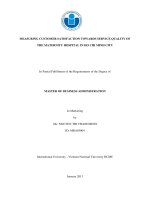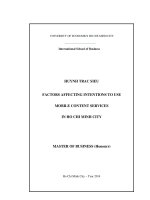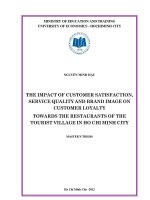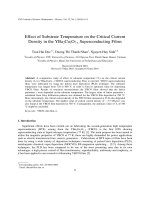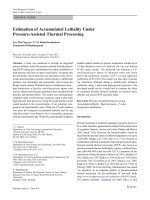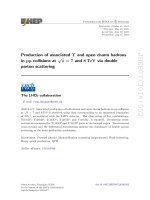DSpace at VNU: Estimation of emission factors of air pollutants from the road traffic in Ho Chi Minh City
Bạn đang xem bản rút gọn của tài liệu. Xem và tải ngay bản đầy đủ của tài liệu tại đây (1.23 MB, 9 trang )
VNƯ Joum al of Science, Earth Sciences 24 (2008) 184-192
Estimation o f emission íactors of air pollutants
from the road traffic in Ho Chi Minh City
Ho Minh Dung*, Dinh Xuan Thang
Institute fo r Envirotiment and Resources, Vietnam National University, Ho Chi Minh City
Received 24 December 2008; received in revised form 27 January 2009.
Abstract. The estimation of emissions largely depends on the quality of emission íactors used for
calculation. The study on the estimation of emission factors is important for calculating the
emission of air pollutants from road traíĩĩc in Ho Chi Minh City (HCMC).
The result of this study is the selection of a suitable method and tracer for estimating emission
factors of 15 volatile organic compounds (VOCs) from C2-C6 and NOx from road traíTic in
HCMC. The survey has been carried out in 3/2 Street, District 10, HCMC firom January to March
2007.
Three VOCs compounds vvith high average emission íactors are hexane (59,7 ± 9,2
mg/km.veh.), iso-pentane (52,7 ± 7,4 mg/km.veh.) and 3-methylpentane (36,1 ± 3,6 mg/km.veh.)
and the average emission factor of NOx is 0,20 ± 0,03 g/km.veh. Besides, the emission íactors of
air pollutants for motorcycles, light-duty vehicles and heavy-duty vehicles are calculated by using
the linear regression method.
Keywords: Emission íactors; Tracer; VOCs; NOx.
1. Introduction
The increasing number of vehicles in
HCMC leads to the increase of harmful
emissions, as well as the concentration of air
pollutants. The calculation of air pollution
emission by road traffic for simulating the
distribution process of air pollutants is of very
importance for environmental management.
Thereíore, the study on determining the
emission factors to calculate emission of air
pollutants from the road traííìc in HCMC is
necessary so far.
Corresponding author. Tcl.: 84-8-38651132.
E-mail:
There are two approaches to determine the
emission íactors by road traffìc: the traditional
approach (bottom up) - directly measurement o f
exhaust gas from each type of vehicle by
dynamometer; and the altemative approach (top
down) - determining the emission íactors based
on real-world traffic conditions.
Dynamometer tests are an essential part of
the methodology required for draíting vehicle
emission [3, 17]. Hovvever, dynamometer tests
can not accurately reílect the importance o f
factors present in on-road situations, such as
actual driving conditions and evaporative
emissions
from
fuel
tanks.
Besides,
dynamometer tests are time consuming, costly,
and the number o f testable vehicles in most
studies is limited.
H .M . Dung, D .x . Thang / VN U Ịoum al of Science, Earth Sciences 24 (2008) 184-192
In recent years, a new approach has been
developed. This approach is based on the
indirect estimation o f emission factors under
real-world conditions. D iíĩerent methodologies
can be considered as top down techniques
including the tunnel studies and the inverse
application o f air quality models at microscale
level. A number o f studies on real-world road
traffic emission factors have been done in road
tunnels (e.g. Staehelin et al. [15]; Kristensson et
al. [10]; Hung-Lung et al. [5]; Hwa et al. [6]).
The advantage o f road tunnel studies is the low
cost, and possibility o f determining emissions
not only from the engines, but also írom
evaporation o f fuel. However, it is not always
possible to fmd a tunnel close or inside the city
were the emissions are produced and which
would represent in a better way the real-world
urban conditions, the classiíĩcation o f vehicle
types is not in detail and only allows us to
calculate emission factors in some limited
ranges o f vehicle speeds.
Another o f top down approach is the
inverse application o f an air quality model (also
called inverse modeling), has been applied for
the first time by Palmgren et al. [13]. This
method describes theoretically the relationship
between emissions, dispersion o f air pollutants
and resulting air pollutant concenừations.
The inverse modeling has been used to
estimate the emission ĩactors in different cities
o f the world [2, 8, 9, 13]. The advantage o f this
technique is that it is possible to estimate the
emissions under real-worId conditions. On the
other hand, since the method uses an air quality
model to estimate the dispersion function, the
accuracy o f the estimated emissions will depend
on the ability o f the model to reproduce the
dispersion o f ửie pollutants.
ưntil now, in Vietnam in general and
HCMC in particular, the study on determining
the emission íactors by road traíĩĩc have been
initially
interested
by
scientists
and
environmental managers. However, due to the
inappropriateness o f research method and the
185
lack of research facilities, until now it has not
been implemented, particularly with ứie method
used tracer experiment to determine the
emission íactors by road traffic.
2. Selection of
emission íactors
method
for
estimating
Đased on the analysis o f advantages and
disadvantages of the ciưrently available
methods, it shows that the inverse air quality
model method is more suitable for the
conditions ofHCMC.
The relationship between air pollutant
concentration (C), emission o f the pollutant (E)
and dispersion, dilution factor (F) írom road
ữaffic is expressed in the basic equation:
c = F(model).E + Cbackground»
(1)
in vvhich, c is the concentration o f a particular
pollutant in the Street (g/m3 or mg/m3); E is the
emission o f the pollutant from road ữaffĩc in
the Street; F is a íunction describing the
dispersion, dilution processes, it depends
mainly on meteorological parameters such as
wind speed and wind direction above the roof;
and Cbacitpound is the contribution to pollutant
concentrations in sữeet from all other sources.
In this study, we determine the dispersion,
dilution íactor F by using tracer experiment
with measurement o f meteorological parameters
to determine the emissions o f air pollutants
based
on
the
measurement
of their
concentrations at the same time with tracer
experiment. The factor F is determined base on
the equation:
Ị7
—
h“
c -C h.backgroimd
*
ĩ?
h
w
For a speciíic hour, h, the average emission
factors o f vehicle and the emission factors for
motorcycles (MC), light-duty vehicles (LDVs)
and heavy-duty vehicles (HDVs) can be
expressed as:
186
H .M . Dung , D.x. Thang / V N U Ịoum aỉ of Science, Earth Sciences 24 (2008) 184-192
E li= e / x n ^ ỵ / N t jl x ạ t ,
(3)
in which, ef is the average errússion factor of
vehicles (g/km/veh.); n is total vehicle number;
N k k and qk are the traííìc flow and emission
factor for the k h vehicle category, respectively.
3. Experimental set up
3.1.
Design o f the experiment system
Experiment system includes two main parts:
the tracer liberation system and equipments for
measuring pollutants and tracer concentration.
Two parts are put at opposite kerb-sides at the
experiment site.
A simple box model from Olcese L. E. [11]
is used to calculate the tracer emission rate
needed. The calculation shows that a continuous
propane emission rate o f 0.21 m3/h (0.38 kg/h)
is enough to reach a propane concentration at
Street level of about 150 ppb. Since there is
39.1% o f propane in LPG, ửie amount o f LPG
needed is 0.54 m3/h (or 9 1/min).
3.2. Experiment site selection
Experiment site is selected based on the
following criteria: with all kind of vehicles, the
high buildings surrounding the Street are not
very different; avoid the iníluence o f industrial
and living activities.
The selecteđ experiment site is locateđ on
the 3/2 Street, District 10, HCMC, in íront o f
the Marximark supermarket. The traffic volume
in this area is very high with 325,000 veh./day
in average and there are often traffic jam s in
rush hours vvith the traíĩĩc volume o f 24,000
veh./hour.
Fig. 1. The survey site (left: in HCMC map; right: in 3/2 Street, 1: Emission liberation device;
2: Mobile station; 3: Trafĩĩc video recording; 4: Weaứier station).
3.3. Selection o f tracer
In the world, tracer is widely used for many
research purposes: (a) investigate tìie ability to
model the air pollution dispersion process in an
urban area; (b) evaluate long-range transport
atmospheric dispersion models in general; (c)
veriíy a two dimensional aừ quality numerical
model in an urban sừeet canyon; (d) determine
the ventilation flux inside road tunnels.
Đased on the requirements and combined
with the real conditions in HCMC, tracer
H.M. D ung, D .x . Thang / VN U Ịournal o f Science, Earth Sciences 24 (2008) 184-192
selected for research is propane with the
reasons that propane is a non-reactive gas,
easily available, it is much cheaper, easy to
detect
with
commercial
on-line
gas
chromatographs, negligible global warming
potential (GWP) and ozone depleting potential
(OPD).
3.4. Experiments
a. Measuremettí o f air pollutants
The air pollutants were measured by
Standard
automatic
devices
from
S.A
Environment, France: Module AC 31M monitor
NOx (N 0 + N 0 2), module MP 101M monitor
PM 2.5 and GC955 with FID and PID monitor
VOCs (C2-C6). All equipments were calibrated
every w eek w ith Standard m ix gas.
b. Tracer experiment
The ữacer liberation system consists of two
parts. The first part is a tracer emission device,
and the second part is an Online gas
chromatograph used to measure the resulting
tracer concentrations.
c. Weather information
The registered meteorological parameters
are: wind speed, wind direction, temperature,
humidity, u v , solar radiation, rain, atmospheric
pressure were measured by vveather station.
This equiment w as placed on the top o f the
building No.3, 3/2 Sừ., Dist. 10, which is located
close to the measuring site (see Fig. 1).
d. Vehicle information
Traíĩìc flow is continuously recorded by a
video camera (see Fig. 1). Traffic volumes are
counted manually
after the measuring
campaign. The vehicles are classiíied into three
diíTerent groups: light-duty vehicles (LDVs)
such as gasoline light-duty passenger vehicles
and light-duty trucks (under approximately 1
ton gross weight); heavy-duty vehicles (HDVs)
such as diesel trucks (above approximately 1
ton gross weight) and buses; and gasoline
motorcycles (MC).
187
4. Results and discussion
4.1. Vehicỉe information
The statistics show that most of vehicles are
MC, and their contribution ranges from 91.3%
to 97.3% (average: 94.6%), the contribution of
LDVs ranged from 2.1% to 6.5% (average:
4.2%), and the contribution o f HDVs ranged
from 0.2% to 2.7% (average: 2.0%). The speed
o f vehicles is changed during the day. The
average speed o f motorcycles is 40.5 km/h; cars
- 42.4 km/h; light trucks - 41.8 km/h; heavy
trucks - 35.7 kxn/h; and buses - 39.7 km/h.
4.2. Air pollutaní concentration
The most abundant VOCs in this research
were hexane, iso-pentane and 3-methylpentane.
These three species account nearly to 60% of
the total VOCs measured. The mean
concentration o f benzene registered in the 3/2
Sừeet exceeds the Vietnamese Standard TCVN
5938:2005 (hourly average 22 fig/m3) with the
ĩactor 2.1. The mean N 0 2 concentration lower
than the Vietnamese Standard TCVN 5937:2005
(hourly average 200 ụg/m3), but sometimes the
N 0 2 concentration exceeds the Standard.
4.3. Tracer concentration
The average propane concentration during
the liberation is well above ửie typical propane
concentration present in the place. Several
factors are related to the dispersion of pollutants
in a Street canyon. The main factors are the
Street and buildings geometry, the prevalent
wind speed and wind directions, and, to some
extent, the traíĩìc induced turbulence.
From 10 am to 2 pm, the wind blows to
diíĩerent dừections and lower wind conditions
prevail. The lowest tracer concentrations are
observed at this period o f the day. From 2 pm to
6 pm, the wind direction is oblique to the Street
axis and the wind speed is higher than in the
moming. At these hours o f the day, tracer
188
H .M . Dung, D .x . Thang / VN U Ịoum al o f Science, Earth Sciences 24 (2008) 184-Ĩ92
concentrations are higher than that in the
moming. From 6 pm to 10 pm, the wind
direction is nearly perpendicular to the Street
axis and the wind speed is also high. Tracer
concentrations from 6 pm to 10 pm are the
highest
observed.
Different
analysis
measurement studies have shown that at high
wind speeds and when ứie wind is perpendicular
to the Street axis, the concentration of pollutants
increases at the leevvard side of the Street.
300
250
ỉ
3
I
1
200
« 150
100
50
10
12
time(h)
14
Fig. 2. Propane concentration in normal level and during tracer experiment.
4.4. Identification o f air poỉlutant sources
Principal Component Analysis (PCA) tool
o f SPSS (Statìstical Product and Service
Solutions) - a povveríul Computer program with
wide variety o f statistical analysis - software
version 15.0 was applied to identify the aừ
pollutant sources. The obtained results are shown
in Table 1. Some remarks can be made as follows:
The factor No 1 (F l) has high loadings for
all of the VOCs except isoprene. VOCs like
isopentane, n-pentane and benzene have been
associated to gasoline vehicle emissions and
gasoline evaporation. Besiđes, NO also has a
high loading in F l, attributed to diesel powered
vehicle emissions, then, F1 corresponds to the
vehicle emissions.
Factor number 2 (F2) has a high loading for
isoprene. Isoprene is associated to biogenic
sources, this voc is also attributed to the road
traffic. Besides, PM 2.5 and N 0 2 are also
associated to F2. N 0 2 is mainly associated to
chemical production, fme particles in HCMC
have been attributed to other sources than
traffic [7]. This PCA analysis confinns that the
road trafTtc is not an important source o f PM 2.5.
Thereíòre, F2 is a group o f the folIowing sources:
biogenic, chemical production and oửier sources.
Table 1. PCA results for air pollutants
No.
Compound
1
2
Propene
Trans-2-butene
1-butene
Cis-2-butene
Iso-pentane
n-pentane
1,3 butadiene
Trans-2-pentene
1-pentene
2-methyl-2-butene
Cis-2-pentence
2,3-dimethy lbutane
2-methylpentane
3-methylpentane
Hexane
Isoprene
Benzene
pm 25
NO
NO,
3
4
5
6
7
8
9
10
11
12
13
14
15
16
17
18
19
20
Factors
F1
0.960
0.961
0.980
0.785
0.970
0.956
0.961
0.954
0.968
0.963
0.978
0.947
0.858
0.979
0.934
F2
0.635
0.911
-0.764
0.537
-0.636
H M . Dung, D .x . Thang / VN U Ịournal o f Science, Earth Sciences 24 (2008) 184-192
4.5. Estimation o f trạffìc emission/actors
The three VOCs with high average emission
4.5. ỉ. Total em ission/actors fo r aỉl vehicles
a. Estimation total emỉssion /actors
Cu background
(V
Since c ,j background is many times lower than
c ,„ we can neglect C ự background in Eq. 4; C 'j is
the concentration o f tracer measured at time /,
£,= 1.912.582 m g/km / 2; h is the propane
emission rate along 100 m hose during 30
minutes. Replacing Eh from Eq. 3 into Eq. 1,
one can obtain:
Q —F ị.n .S f + c , bachground
factors were n-hexane, iso-pentane, and 3methylpentane. The average emission ĩactors of
NO,(NO) is 0,20 ± 0,03 g/km.veh.
Total emission of pollutant was calculated
by using Eq. 1, where the dispersion, dilution
íactor (F) is estimated by tracer experiment:
F r' Ct.
189
( 5)
In the above equation, Cị is the
concentration of pollutant; n is the total number
of o f vehicles at time /, ẽf is the average
b. Comparison with other studies
Comparison of the average emission íactors
of VOCs in this study wiửi some other studies
in Japan [8], Taiwan [5, 6], Korea [12], and
France [16] expressed in Table 2 showed that
there are almost no difference between the
emission íactors of VOCs obtained in this study
and that in Taiwan, only the emission íactors of
3-methylpentane and hexane were higher with
the íaclors from 6 to 8 times. The difference
with the study in Korea is not so much.
Emission
íactors
of
iso-pentane,
3
methylpentane, hexane were higher with the
factors from 2 - 4 times. However, the emission
em ission íacto r (m g /k m .v eh ) and c , background is
factor o f trans-2-butene, cis-2-butene, benzene,
the background concenừation o f pollutant at
time i.
etc were lower. The comparison with the study
The slope of linear regression graph of the
n.Fi vs c, plot may coưespond to the emission
íactor e/(mg/km.veh) for that speciíic pollutant.
The dispersion factor Fj is independent on the
pollutant type and it can be used to calculate the
emission rates for any pollutant monitored.
Cbackground o f air pollutants can also be estimated
from that equation.
results in France shows that the emission factor
o f propene and iso-pentane in HCMC is higher.
Conversely, the emission íactors o f 3methylpentane and hexane were lower. The
coincides with all studies that the value of
emission factor o f iso-pentane is highest in all
VOCs from C2-C6. Thus, it can be said gasoline
is the fuel commonly used in the vvorld.
190
H M . Dung, D .x . Thang / VN U Ịournaỉ o f Science, Earth Sciences 24 (2008) 184-192
Table 2. The average emission íactors of VOCs and NOx (mg/km.veh)
Compound
ef
Propenc
Trans-2-Butene
1-Butene
Cis-2-butene
iso-pentane
n-Pentane
Trans-2-Pentene
1-Pentene
2-methyl-2-butene
Cis-2-Pentene
2,3-Dimethylbutane
2-Methylpentane
3-Methy!pentane
n-Hexane
Benzene
NO, (NO)
19.8
38
3.8
3.6
527
16.4
9.9
3.5
2.6
CI
(%)
9
17
11
17
14
11
15
12
14
12
3.3
7.7
7.3
36.1
59.7
10.7
200.6
cb
(ppb)
19.1
6.0
4.3
5.7
97.2
25.8
18.9
4.3
4.4
4.0
11 9.5
12 9.1
10
16
13
15
47.5
106.2
14.9
39.3
c
Study
(I)
(ppb)
29.5
7.9
6.3
7.5
122.9 11.0
33.7
5.0
23.8
5.9
5.6
5.6
13.6
12.8 65.6
5.9
136.5 20.4
5.2
128.5
Study
(2)
11.61
1.61
8.27
1.84
12.50
9.52
2.7Ộ
1.61
1.59
1.33
5.27
6.39
4.18
12.21
-
(3)
Study
(4)
Study
Study
(5)
10.4
19.3
63
21.9
19.6
1.2
3.0
-
61.2
7.7
10.7
5.7
153.0
10.36
0.81
10.67
1.56
40.07
19.28
4.08
0.97
-
6.7
15.1
18.6
19.1
13.0
20.6
-
12.6
6.5
3.3
3.4
15.4
9.1
5.5
-
1.57
12.70
12.56
5.62
5.70
5.87
-
Note: CI: Coníĩdence interval; Cb:Background concentration; C: Average concemration of aừ pollutants;
(,)Kawashima H. et al, 2006 [8]; (2)Hwa M. Y.et al , 2002 [6]; (3)Na K. et al., 2002 [12]; (4>Touaty M. et al., 2000
[16]; (5)Hung-Lung c. et al., 2007 [5].
The comparison in Table 2 shows that the
average emission factor o f NOx in this study is
lower than the result o f researchers around the
world. This can be explained by the diíĩerences
in the rate o f HDVs type (diesel vehicles) in the
total number o f vehicles, since NOx emitted
from diesel vehicles is higher than that from
gasoline vehicles. In the research in HCMC,
HDVs contribute only about 0.5% o f the total
number o f vehicles, while according to results
of research Hung-Lung c . [5], the HDVs is
about 15%. Similarly, in the research o f Hwa Y.
[6], the HDVs is about 7%, and John c . [7] -12%.
4.5.2. Emission/acíorsforMC, LDVs & HDVs
a. Calculation o f emission /actors
Emission factors o f air pollutants for MC,
LDVs and HDVs are determữied by using the
followúig equation:
Eh,i = S f X t ỉ = N mc X q MCị +
(6)
^
LDVi x Q m V ỉ.i + N HDy ,
X <ỈHDVỊ,i
in \vhich, Eh is hourly average total emission of
air pollutants; NMC, N ldvs, NHyDl are traffic
volumes for MC, LDVs, and HDVs; qMC, <ỈLDVỉ,
Qhvdĩ are emission íactors o f air pollutants for
each type o f vehicles; i is the time o f estimating
emission íactors.
E q .6 is showed by linear regression method
using SPSS 15.0 soíhvare. Emission íactors of
VOCs for MC in range 5,3 - 149,9 mg/km.veh.,
for LDVs in range 0,04 - 1,97 g/km.veh., and
for HDVs in range 0,21 - 5,71 g/km.veh. In
VOCs, the emission factors o f iso-pentane is
highest with 149,9 ± 46,4 mg/km.veh. for MC;
1,97 ± 0,61 g/km.veh. for LDVs and 5,71 ±
1,60 g/km.veh. for HDVs. In general, the
emission factors o f iso-pentane has a high value
because iso-pentane is One o f the VOCs emitted
from engine and evaporation from fuel tank.
b. Comparison wiíh other studies
H .M . D ung, D .x . Thang / V N U Ịourrtal o f Science, Earth Sciences 24 (2008) 184-192
191
Table 3. Comparison emission íactors ofNO„ with other studies (g/km.veh.)
1.
2
Author/research
This study
Tsai J. et al., 2000 [18]
MC
0.43 ± 0.04
0 46 ± 0.04
3.
Tsai J. et al„ 2003 [17]
0.25 ±0.13
0.15 ±0.06
4.
5.
6.
John c . etal., 1999 [7]
Kristensson A. et al., 1999 [10]
Zarate E. et al., 2007 [191
No.
0.18 ±0.07
-
-
Comparison with the other studies in the
world shows that the emission factors o f NO*
for MC in this study is not different with the
study in Taiwan [17, 18]. Similarly, the
emission factors o f NO* for LDVs and HDVs
also not so different with the results o f stuđy in
Switzerland [7] and Columbia [19].
Comparison o f results in this study with
some studies in Japan [8], the United States
[14] shows that there is a large difference in the
emission factors o f VOCs for LDVs and HDVs.
The emission ĩactors calculated in this study are
generally higher compared to the results o f the
other studies around the world. Only the
emission factor o f VOCs for MC has a little
diíĩerence with thc results in Japan.
The difference o f emission factors in this
study and the other studies can be explained by
the following reasons: the difference of
components in the fuel types used; type and age
of the engines; circulation conditions of
vehicles; topography o f the study area.
LDVs
1.07 ±0.23
HDVs
17.38 ±4.05
Note
.
•
New
In use
-
-
04 stroke - new
04 stroke
1.05 ±0.09
1.07 ±0.03
0.11 ±0.02
15.59 ±0.79
8.0 ±0.8
18.9 ±0.37
-
-
2. This is the ĩirst time that the
measurement and experiment is implemented in
Vietnam to calculate the emission íactors of 15
VOCs from C 2 - c6 and NOx(NO) by road
traffic in HCMC. The obtained results show
that motorcycles have the average rate of
94.6%, light-duty vehicles - 4.2%, and heavyduty vehicles -1.2% .
Three VOCs which yield the highest
average emission íactors are n-hexane (59.7 ±
9.2 mg/km.veh.), iso-pentane (52.7 ± 7.4
mg/km.veh.) and 3-methylpentane (36.1 ± 3.6
mg/km.veh.), the average emission íactor of
NOx(NO) is 0.20 ± 0.03 g/km.veh. Especially,
in this study the authors has been estimated the
emission íactors o f VOCs and NOx(NO) from
motorcycles, which are considered to be the
most popular transportation vehicles in HCMC.
3. Comparison o f the obtained results with
other overseas studies shows that there is no
diíĩerence on the average emission íactors ọ f
VOCs, but the average emission factors of
5. Conclusions
NOx(NO) in this research is lower in
comparison with other researches. However, the
1.
Based
on
the
advantages and
emission íactors o f VOCs for MC, LDVs and
disadvantages o f meứiods for determining
HDVs in this research is higher compared with
emission íactors combined with the real
other researches, but NO*(NO) does not show a
conditions o f HCMC, the authors have used a
large diíĩerence. The reason o f differences can
new approach o f inverse modeling air quality
be explained by diíĩerent component types of
combination
ừ acer
experiment
and
fuel used, the ratio between the types of
measurement to identiíy emission factors o f air
vehicles,
type and age o f the vehicle and
pollution dae to road traffic in HCMC. In this
topographical íactors, etc.
research, propane is chosen as the suitable tracer.
192
H .M . Dung, D .x . Thang / VN U Ịoum al of Science, Earth Sciences 24 (2008) 184-192
5.
The íurther research is to improve the
methods for determining emission factors in
HCMC in particular and Vietnam in general.
[8] H. Kavvashima, s . M inami, Y. H anai, A.
Fushimi, V olatile organic com pound em ission
íactors
from
roadside
m easurem ents,
Atm ospheric E nvironm ent 40 (2006) 2301.
[9] M. Ketzel, p. VVahlin, R. B erkow icz, F.
Palm grcn, Particle and trace gas em ission íactors
unđer urban driving conditions in Copenhagcn
Acknowledgements
based on Street and roof-level observations,
The authors are grateful to the ABC (Asia
Brown Cloud) Project, which is the cooperation
between Institute o f Environment and
Resources and Swiss Federal Institute of
Technology (EPFL), for íìnancial and technical
support.
A tm ospheric E nvironm ení 37 (2003) 2735.
[10] A. Kristensson ct al., Rcal-world íraffic em ission
íactors o f gases and particlcs measured in a road
tunnel in Stockholm , Sweden, A tm ospheric
Environment 38 (2004) 657.
[11] L.E. O lcese, G. G ustavo Palancar, M. Toselli
Beatriz, An inexpensive m ethod to estim ate c o
and NOx emissions firom TTiobile sources,
Atm ospheric E nvironm ení 35 (2001) 6213.
[1] A. Ghenu, J.M . Rosant, J.F. Sini, Dispersion o f
[12] K. Na, K. M oon, Y.p. Kim, Determ ination o f
non-methane hydrocarbon cmission íactors from
vehicles in a tunnel in Seoul in M ay 2000,
K oreanJ. Chem. Eng. 19(3) (2002)434.
pollutants and estimation of emissions in Street
[13] F. Paỉm gren, R. Berkow icz, Actual car ílcct
Reíerences
canyon in Roucn, France, Environm ental
M odeling & Softw are 23 (2008) 314.
z.
[2] G. Gram otnev, R. Brown,
Ristovski, J.
Hitchins, L. M orawska, Determ ination o f
average em ission íactors for vchicles on a busy
road, Atm ospheric Environment 37 (2003) 465.
[3] N .v . Heeb, A.M . Forss, c . Bach, A com parison
o f benzene, toluene and c 2-benzenes mixing
ratios in autom otive exhaust and in the suburban
atmosphere during the inừoduction o f cataỉytic
converter technology to the Swiss Car Fleet,
Atmospheric Environment 34 (2000) 3103.
[4] p. Hien, N. Binh, Y. Truong, N. Ngo, L. Sieu,
Com parative rcccptor m odeling study o f TSP,
PM2 and PM 2.|0 in Ho Chi Minh City,
Atmospheric Ertvironment 35 (2001) 2669.
[5] c . Hung-Lung, H. Ching-Shyung, c . Shih-Yu,
w . M ing-Ching, M. Ma Sen-Yi, H. Yao-Sheng,
Emission íactors and characteristics o f criteria
poỉlutants and volatile organic com pounds
(VOCs) in a frccway tunnel study, Science o f the
Total Environm ent 381 (2007) 200.
c.c.
T.c.
[6] M.Y. Hwa,
Hsieh,
W u, Real-world
vchicle em issions and VOCs proíĩle in the
Taipei tunnel ỉocated at Taiwan Taipei area,
Atmospheric Environmeftt 36 (2002) 1993.
[7] c . John et al., Com parison o f emission factors
for road traííìc ữoTTì a tunnel study (Gubrist
tunnel, Switzerland) and
from
cmission
m odeling, A im ospheric Environment 33 (1999)
3367.
em issions
e stim a te d
ÍTom
urban
air
quality
m easurem ents and Street pollution m odels, The
Science o f th e Total Environment 235 (1999)
101.
[14] J.c . Sagebiel, B. Zielinska, w . R Pierson, Realworld em issions and calculated reactivitics o f
organic
species
from
motor
vehicles,
Atmospheric Envừvnm ent 30, 12(1996)2287.
[15] J. Staehclin, c . Keller, w. Stahel, K. Schlapfcr,
s. Wunderli, Emission íactors from road ừaíTic
from
a
tunnel
study
(Gubrist
tunnel,
Switzerland). Part III: results o f organic
com pounds, S 0 2 and spcciation o f organic
cxhaust em ission, Atm ospheric Environmení 32,
6 (1 9 9 8 )9 9 9 .
[16] M. Touaty, B. B onsang, Hydrocarbon em issions
in a highw ay tunnel in the Paris arca,
Atm ospheric E nvironm ent 34 (2000) 985.
[17] J.H. Tsai, H. L Chiang, The speciation o f
volatile organic com pounds (VOCs) from
motorcycle engine exhaust at diíĩerent driving
modes, A tm ospheric Environment 37 (2003)
2485.
[18] J.H. Tsai, Y.c. Hsu, H.c. Weng, W.Y. Lin, F.T.
Jcng, A ir pollution em ission ĩactors from new
and in-use motorcycles, Atmospheric Environment
34 (2000) 4747.
[19] E. Zarate, L. Belalcazar, A ir quality modelỉing
over B ogota, C olom bia: com bined techniques to
cstim ate and evaluate cm ission inventories,
Atm ospheric E nvironm ent 41 (2007) 6302.

